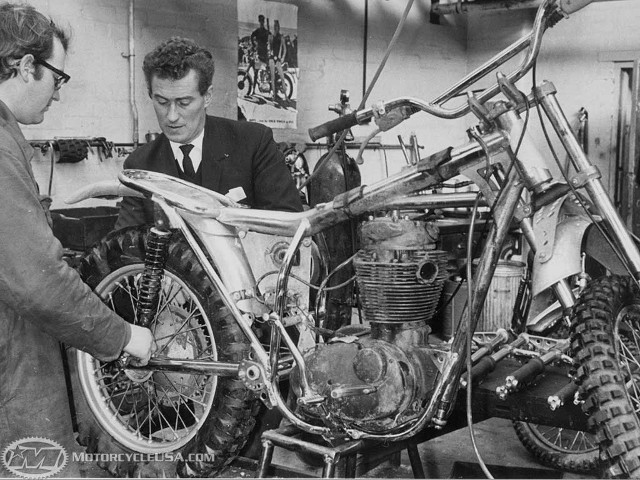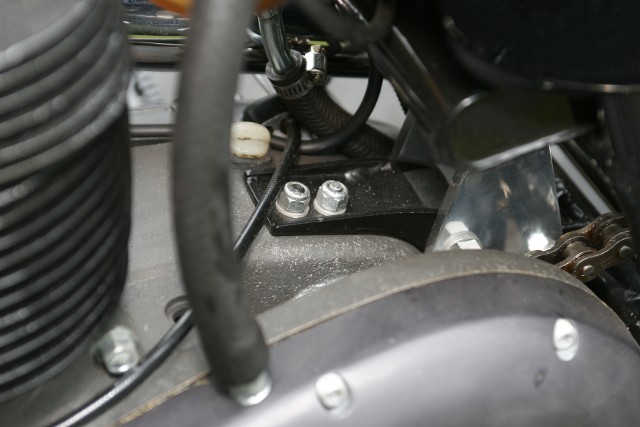This site is for people who love, admire, want, are curious about or are just interested in the BSA GP VICTOR motorcycle
(Further page navigation at the foot of each page - including bits you can get for your GP)

History
Evolution of the Victor It began with the C15 and Brian Martin. He took a C15 from the production line, removed the lights, added larger wheels, alloy tank and upswept exhaust and got a winner. Over the next two years Jeff Smith and Arthur Lampkin finished second in the 250 European Motocross Championship. By that time, many of the components essential to the success of a product had been developed and tested. The swan neck frame had gone to be replaced by the Victor Enduro/Roadster design. The rear hub and brake, pedal and pivot pin had been produced. When the B40 came along to be developed it benefitted from the new frame and ancillaries. Between early 1961 and Good Friday 1962 the B40 engine was developed into the 421 and before the 1964 World Motocross Championship began the bike that would take that year’s title was created. By that time the airbox, seat, 7” front wheel with floating shoes and the front forks were ready. The frame had oil in the frame and the little tank under the airbox. It weighed 228 lbs. Production Issues There is evidence to suggest that initially frames were produced in batches and stamped at the time they were produced. Engines were produced and stamped separately, married up with a frame and completed as and when a batch was required. This was later amended such that the frames were not stamped at the time of manufacture but only when the engine was installed and the frame got the same number as the engine. So from 551 onwards GPs had matching frame and engine numbers. There was a concern that stamping the frame after painting caused rust where it was stamped. (The Enduros had matching engine and frame numbers from the start). All B44 engine production for the 1966 season (GP and E) shares one numbering sequence from B44 101 upward, production beginning in 9/65. Engines are stamped/numbered at or during engine assembly and are built to either GP or Enduro specification. B44E engines have the "E" added by completion to differentiate them. The first batch of engines are built using sandcast cases and are numbered 101 to 216. All of the first batch are built to GP specification except for 4 built to Enduro specification. The first batch of GP frames is numbered 101 to 293, being stamped with the number as a bare frame. First batches of pre-stamped frames and engines are united randomly to build GP machines hence numbers don't match except for one - happy accident. This follows BSA common practice at the time although the Enduros were treated differently! By 13/1/66 the first batch of engines has been used up. The remaining frames from the first batch are built up into complete GP machines using engines taken from the common B44 engine numbering sequence - but these numbers are much higher than the first batch as volume B44E production got underway by 1/66. The engines numbered higher than 216 i.e. after the first batch, no longer use sandcast cases. After the first batch of GP frames has been used, further GP machine completion is determined by the rate at which new GP frames are produced. When a small number of frames are ready a batch of GP machines is produced with engines requested on an ad-hoc basis to be built to GP spec rather than "E". In keeping with BSA practice at this time ( it changed)- the move to matching frame and engine numbers on all production machines - the frames are now NOT stamped prior to machine assembly. Frame numbers are now stamped to match engine numbers after the engine is fitted. Hence the large gaps in the numbering of GP machines, when new small batches of GP engines are requested the number reached in the sequence has moved on considerably due to the high volume of B44E production and this determines the frame number to be used. GP numbering continued to share the B44 numbering system with B44Es to the end of production.(GP continuing in limited production to 1/68 after B44E production ended 3/67). There are a few small anomalies relating to the first GP batch, understandably perhaps, notably the "missing" 30 or so engines and frames which appear not to have been used. Thanks to Rupert Ratio for researching and documenting the above.
BSA Competition Dept
The three pictures above show firstly the extended rear engine plates, secondly the steel strengthening plate bolted through the rear lug and thirdly the "bolt-on" output bearing - the magnesium cases would not support the bearing otherwise. The first B50 type swinging arm (adjustment at the front) on a new steel frame appeared in January 1966 i.e. before the titanium bikes. Graham thought there had been at least one GP frame modified similarly. Lo and behold, if you look in the book "Rolling Thunder" you will see a picture of Alan Clews GP complete with front adjusting chain - I did not notice this until Graham mentioned it. The later trials bikes with C15 engines appear to have GP frames before the "Otter" type appeared. Comerfords appear to have aquired one fairly early - the frames are very light compared to a C15 frame, even a C15C. Alan Lampkin built his 1966 Scottish Six Days Trial winning bike from a production frame and a C15 engine. There are photos of Scott Ellis on pp309 and 310 of Norman Vanhouse' book BSA Competition History, on oif bikes, that on p. 309 appears to have a nickel plated frame, mag yokes, pre-mag works fork legs and Bantam hubs. See the "Otter" site for more www.bsaotter.com . Details from "On the Rough" by Peter Fraser, The Motor Cycle 27th January 1966 Peter reported on a TV scramble the previous saturday where JVS had appeared on a new bike with a new frame. The frame was all welded with no forging to connect up the front down tube with the engine cradle. The little oil tank had gone. The top tube was bigger. The swinging arm was adjusted at the front (as B50 was to be). The engine was the new works 494cc. The frame was painted silver. The front forks from the GP. The front hub was some light alloy concoction. The Fork yokes were some light alloy.The wheel rims were painted. It had GP seat, side panels and air-box. The coil was mounted high under the rear of the tank. The tank had a Monza cap. This bike must have been developed at the same time as the titanium bike. Details from the Motor Cycle 5 Jan 1967 Brian Martin took 5 GP frames from the production line in 1968 - recorded in the despatch records. Comps must have run out of the Ken Sprayson lightweight frames. Ken is quite clear that he made no more than 9 Victor frames. All made at Reynolds. There are pictures of John Banks and Dave Nichol on GP framed bikes in 1968 . Funnily enough if you talk to JVS about the GP he relates to the bikes he rode in GPs , which were not the Production bikes (apart from a couple of GPs)- he doesn't appear to like them very much possibly because they were heavier than his works bikes - the production bikes were just a snapsot at a moment in time of the state of development say, the end of 1964. Works Celebration To celebrate the World Championship a special dinner for employees involved was held in the Directors Dining Room at the works, commemorated by an invitation with a picture of the GP , the outline cut aound, that opened up to provide the menu and list of proceedings. What makes a GP different from other Victors? The frame - This is made from Reynolds 531 tubing and is much lighter than Enduro and Victor Special frames. It is bronze welded. The frame should never be welded with a Mig or similar, you will "burn" the material, neither should things like propstands be added - the frame material is too thin and soft to withstand these. The forks and front wheel - substantially as per the Victor Enduro with the exception of the front brake fulcrum which has a floating arrangement - see Services page and image and chrome plated fork stanchions. The footrests - these are unique although similar to the Victor Enduro - machined to "catch" a matched lug on the frame, strangely the GP is at a right angle to the Enduro - GPs and early Enduros were solid, later Enduros folding. Works bikes used the same footrests - some were titanium. The brake pedal is unique although similar to the production B50 - derived from casting 40-7022 (also used on the works bikes). The rear mudguard - is unique to the GP - is flatter, wider and shorter than any other (also used on the works bikes). Beaded all round. The airbox is unique to the GP (also used on the works bikes). The seat is unique to the GP (also used on the works bikes). The rear brake backplate is unique to the GP - it is thicker than the production versions for all other models (also used on the works bikes). The rear brake drum is unique (also used on the works bikes). The rear "crinkle" hub is from earlier pre-unit models and has a grease nipple but no speedo drive , instead it has a plain push fit end plate. The oil pipe from the front engine mount is protected by a steel spring - I am looking to reproduce these from 50 thou piano wire - they will cost around £50.
|



